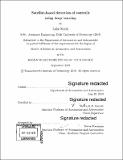| dc.contributor.advisor | Steven R.H. Barrett. | en_US |
| dc.contributor.author | Kulik, Luke. | en_US |
| dc.contributor.other | Massachusetts Institute of Technology. Department of Aeronautics and Astronautics. | en_US |
| dc.date.accessioned | 2020-03-23T18:10:08Z | |
| dc.date.available | 2020-03-23T18:10:08Z | |
| dc.date.copyright | 2019 | en_US |
| dc.date.issued | 2019 | en_US |
| dc.identifier.uri | https://hdl.handle.net/1721.1/124179 | |
| dc.description | Thesis: S.M., Massachusetts Institute of Technology, Department of Aeronautics and Astronautics, 2019 | en_US |
| dc.description | Cataloged from PDF version of thesis. | en_US |
| dc.description | Includes bibliographical references (pages 53-56). | en_US |
| dc.description.abstract | Aircraft condensation trails, known as contrails, are estimated to account for approximately half of all climate warming resulting from aviation emissions, but uncertainty in coverage is high [12, 2]. These artificial clouds form behind aircraft and trap outgoing infrared radiation, leading to a warming effect [12, 3, 28, 40, 3]. With aviation forecast to contribute up to 15% of total anthropogenic warming by 2050 [18], an accurate estimate of total contrail-attributable warming is required. Automated detection of contrails using satellite images has not been feasible to date due to the complex evolution of contrail shapes and their similarity to cirrus clouds and land features [21, 12, 39]. This has been a limiting factor in quantifying contrail climate impacts [39, 3]. We use a deep learning approach to overcome these difficulties. | en_US |
| dc.description.abstract | Instead of relying on fragile, hand-engineered features, we train a deep convolutional neural network directly on a dataset of annotated infrared images from a geostationary satellite. We estimate year-round contrail coverage over the continental United States, based on automated classification of imagery extracted from the Geostationary Operational Environmental Satellite system. We find that contrails cover an average of 0.55% of the contiguous United States, an area equivalent to a quarter of the size of Florida. We show that the relationship between total contrail coverage and air traffic varies as a function of time and location, with greater contrail area produced in early morning than in the afternoon even if traffic volume is the same. We also find a seasonal dependence, with contrail coverage reaching a minimum in late summer at the same time that air traffic peaks. | en_US |
| dc.description.abstract | We create contrail maps showing maxima over major air traffic hubs like San Francisco, Chicago, Dallas and highlighting major contrail-producing airways. We release the first publicly available benchmark dataset of contrail annotations to serve as a platform for future research of contrail formation and impacts. | en_US |
| dc.description.statementofresponsibility | by Luke Kulik. | en_US |
| dc.format.extent | 56 pages | en_US |
| dc.language.iso | eng | en_US |
| dc.publisher | Massachusetts Institute of Technology | en_US |
| dc.rights | MIT theses are protected by copyright. They may be viewed, downloaded, or printed from this source but further reproduction or distribution in any format is prohibited without written permission. | en_US |
| dc.rights.uri | http://dspace.mit.edu/handle/1721.1/7582 | en_US |
| dc.subject | Aeronautics and Astronautics. | en_US |
| dc.title | Satellite-based detection of contrails using deep learning | en_US |
| dc.type | Thesis | en_US |
| dc.description.degree | S.M. | en_US |
| dc.contributor.department | Massachusetts Institute of Technology. Department of Aeronautics and Astronautics | en_US |
| dc.identifier.oclc | 1144176218 | en_US |
| dc.description.collection | S.M. Massachusetts Institute of Technology, Department of Aeronautics and Astronautics | en_US |
| dspace.imported | 2020-03-23T18:10:07Z | en_US |
| mit.thesis.degree | Master | en_US |
| mit.thesis.department | Aero | en_US |
